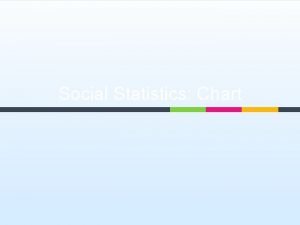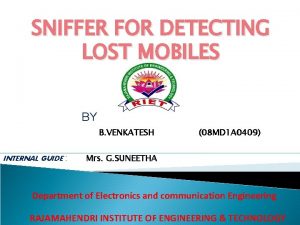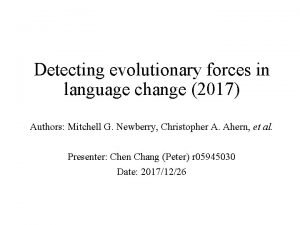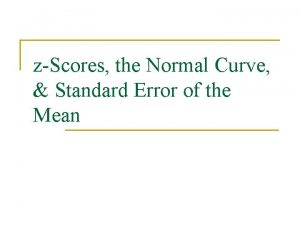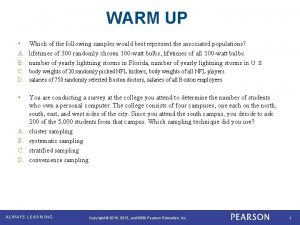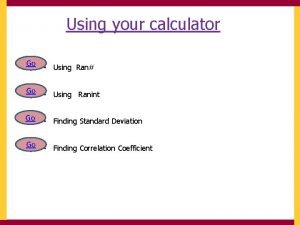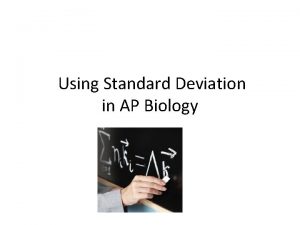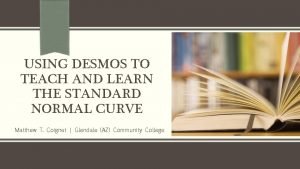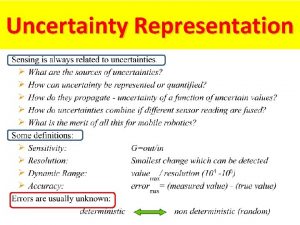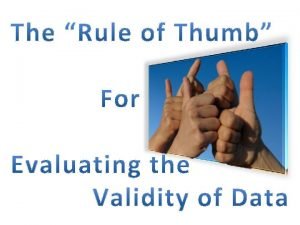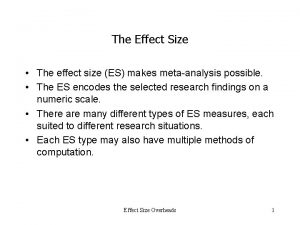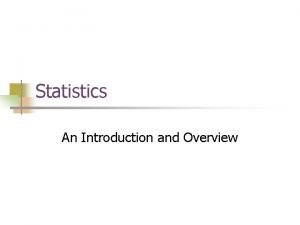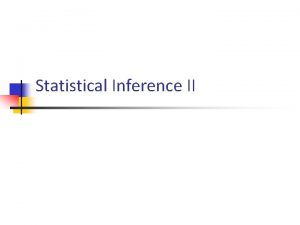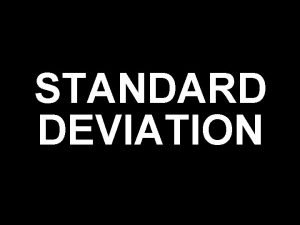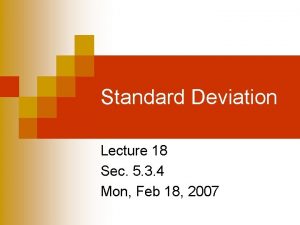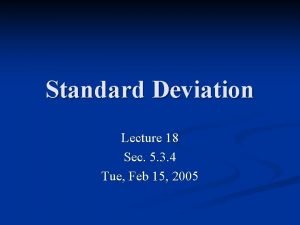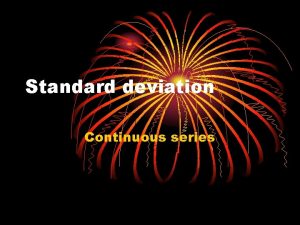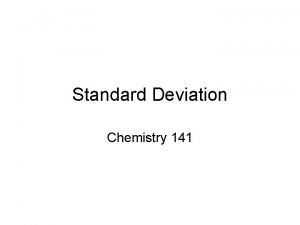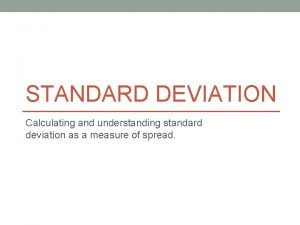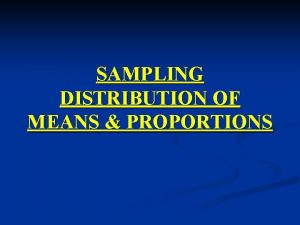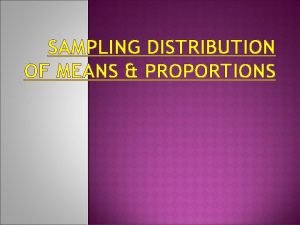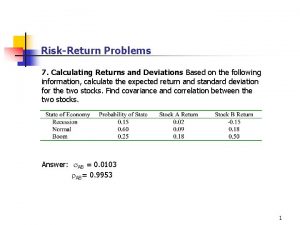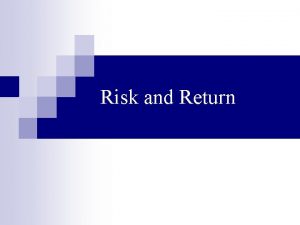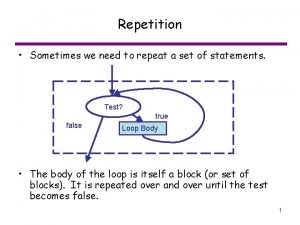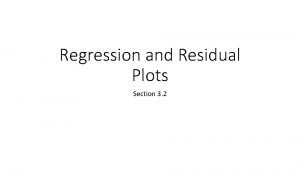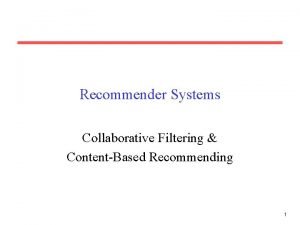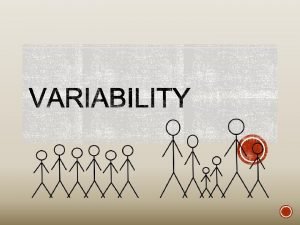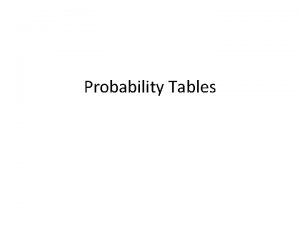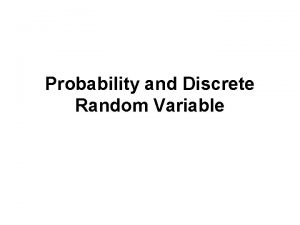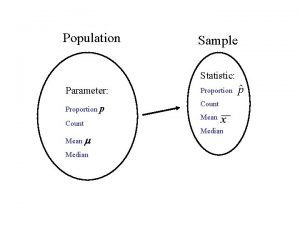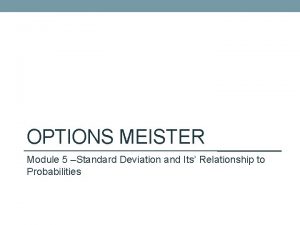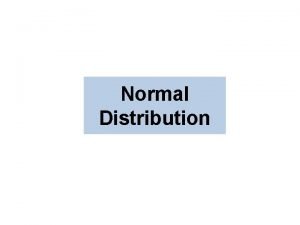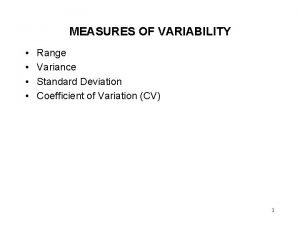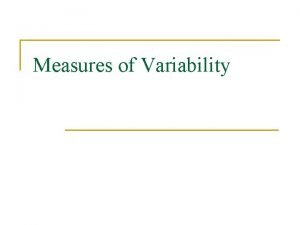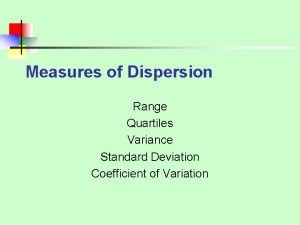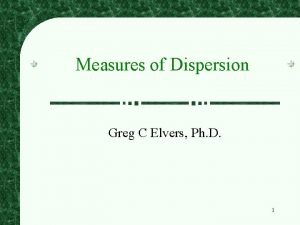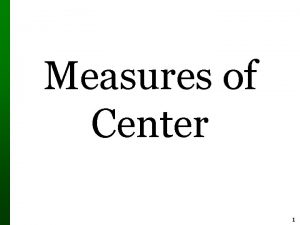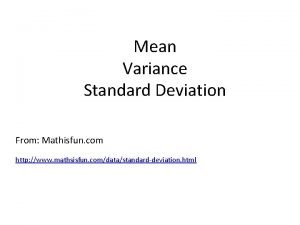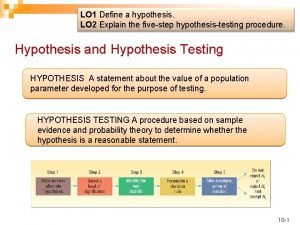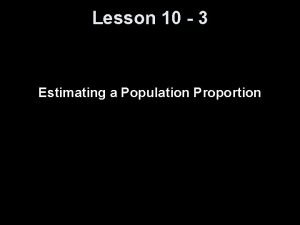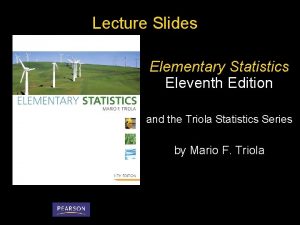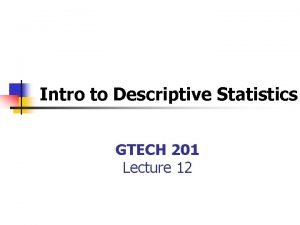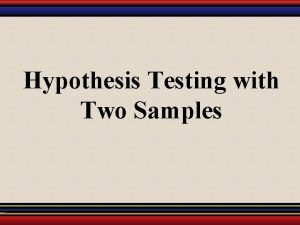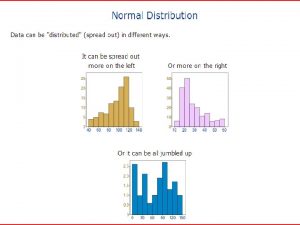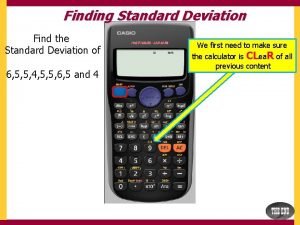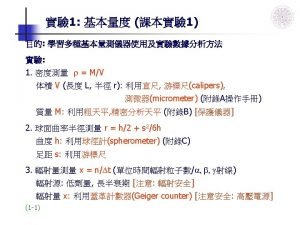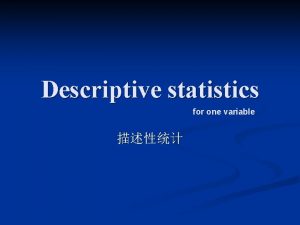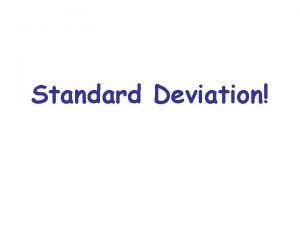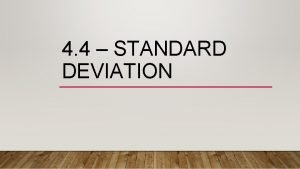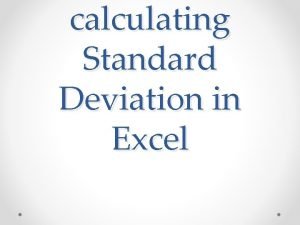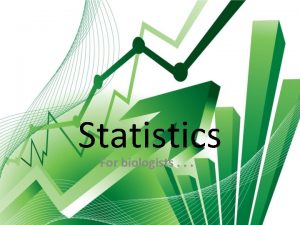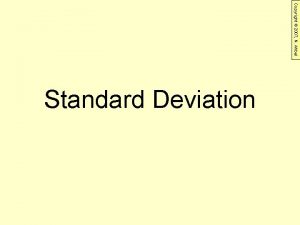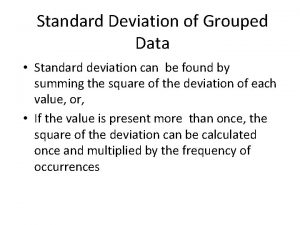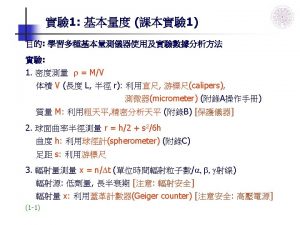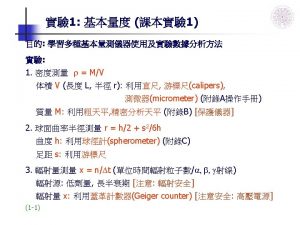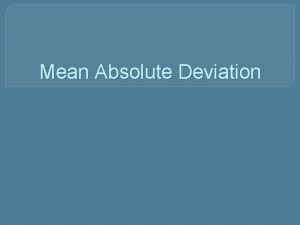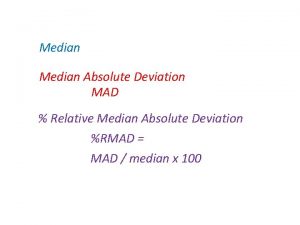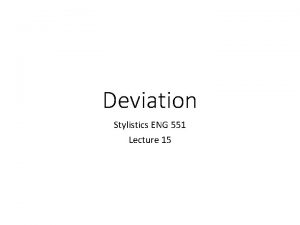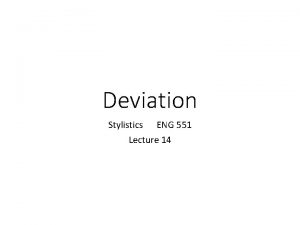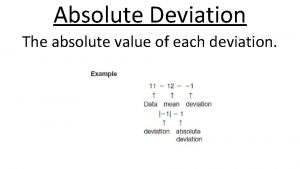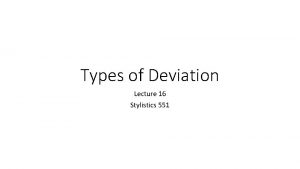Review Detecting Outliers Review Detecting Outliers Standard Deviation


























































- Slides: 58

Review Detecting Outliers

Review Detecting Outliers – Standard Deviation – Percentiles/Box Plots – Suspected and Highly Suspected Outliers

Review Detecting Outliers – Standard Deviation – Percentiles/Box Plots – Suspected and Highly Suspected Outliers

Review Detecting Outliers – Standard Deviation • • • Chebyshev’s Rule Emperical Rule Which points are within k standard deviations? Z-scores Suspected and Highly Suspected Outliers

Review Detecting Outliers – Percentiles/Box Plots • Find Percentiles • Find Qu, M, QL, IQR. – *** Use the method I showed you, not your calculator*** • Building a box plot – Calculate the Upper/Lower Inner and Outer Fences – *** Use the method I showed you, not your calculator*** – Include a menu and show all your work • Suspected and Highly Suspected Outliers

Examples

Big Picture Detecting Outliers

Big Picture (Outliers) Typically we know a lot of historical data about what we are trying to test. From that data we estimate what the population center (the mean) and population standard deviation are. We can: 1) make predictions (within a certain percentage chance) about future events. 2) collect new data and check to see if that would be an outlier in the old data.

Probability

Probability An experiment is any process that allows researchers to obtain observations. An event is any collection of results or outcomes of an experiment. A simple event is an outcome or an event that cannot be broken down any further.

Example Rolling a die is an experiment. It has 6 different possible outcomes An example of an event is rolling a 5. Rolling a 5 is a simple event. It cannot be broken down any further.

Example Rolling a die is an experiment. It has 6 different possible outcomes. Another example of an event is rolling an odd number. This event can be broken down into three simple events: Rolling a 1, rolling a 3 and rolling a 5.

Sample Space The sample space for an experiment consists of all simple events. Example: When we roll on die the sample space is: 1, 2, 3, 4, 5, 6

Sample Space Example: When we roll on die the sample space is: 1, 2, 3, 4, 5, 6 Example: When we roll two dice the sample space is:

Sample Space Example: When we roll two dice the sample space is all possible pairs of rolls 1, 1 2, 1 3, 1 4, 1 5, 1 6, 1 1, 2 2, 2 3, 2 4, 2 5, 2 6, 2 1, 3 2, 3 3, 3 4, 3 5, 3 6, 3 1, 4 2, 4 3, 4 4, 4 5, 4 6, 4 1, 5 2, 5 3, 5 4, 5 5, 5 6, 5 1, 6 2, 6 3, 6 4, 6 5, 6 6, 6

Sample Space We often represent the sample space with a Venn Diagram. Sample Space Event Simple Events (all the red dots)

Sample Space Usually the simple events are not included in our diagram Sample Space Event Simple Events

Sample Space Here is a Venn Diagram depicting two events which overlap, or intersect.

Assigning Probabilities Sample Space Event Simple Events (all the red dots)

Assigning Probabilities Each Simple event has a probability associated with it.

Assigning Probabilities Each Simple event has a probability associated with it. This is really the relative frequency of the simple event.

Assigning Probabilities Each Simple event has a probability associated with it. This is really the relative frequency of the simple event. To find the probability of an event, add up the probabilities of the simple events inside of it.

Example A cage contains 7 black mice, 4 brown mice and 1 white mouse. A mouse is selected at random from the cage. What is the probability it is either a black mouse or a white mouse? Black Brown White Total Frequency 7 4 1 12

Example A cage contains 7 black mice, 4 brown mice and 1 white mouse. A mouse is selected at random from the cage. What is the probability it is either a black mouse or a white mouse? Black Brown White Total Frequency Probability 7 7/12 4 4/12 1 1/12 12 1

Example A cage contains 7 black mice, 4 brown mice and 1 white mouse. A mouse is selected at random from the cage. What is the probability it is either a black mouse or a white mouse? P (Black or White) =

Example A cage contains 7 black mice, 4 brown mice and 1 white mouse. A mouse is selected at random from the cage. What is the probability it is either a black mouse or a white mouse? P (Black or White) = P(Black) +P(White)

Example A cage contains 7 black mice, 4 brown mice and 1 white mouse. A mouse is selected at random from the cage. What is the probability it is either a black mouse or a white mouse? P (Black or White) = P(Black) +P(White) = 7/12 + 1/12 = 8/12

Sample Space Example: Roll two dice. What is the probability of rolling a 9? 1, 1 2, 1 3, 1 4, 1 5, 1 6, 1 1, 2 2, 2 3, 2 4, 2 5, 2 6, 2 1, 3 2, 3 3, 3 4, 3 5, 3 6, 3 1, 4 2, 4 3, 4 4, 4 5, 4 6, 4 1, 5 2, 5 3, 5 4, 5 5, 5 6, 5 1, 6 2, 6 3, 6 4, 6 5, 6 6, 6

Sample Space Example: Roll two dice. What is the probability of rolling a 9?

Sample Space Example: Roll two dice. What is the probability of rolling a 9?

Properties of Probability

Union The union of events A and B is the event that A or B (or both) occur.

Union The union of events A and B is the event that A or B (or both) occur. A or B A B

Intersection The intersection of events A and B is the event that both A and B occur.

Intersection The intersection of events A and B is the event that both A and B occur. A and B A B

Compliment The compliment of an event A is the event that A does not occur.

Compliment The compliment of an event A is the event that A does not occur. AC

Compliment The compliment of an event A is the event that A does not occur. We use AC to denote the compliment of A. P(AC)= 1 - P(A)

Compliment The compliment of an event A is the event that A does not occur. We use AC to denote the compliment of A. P(A)= 1 - P(AC)

Example For an experiment of randomly selecting one card from a deck of 52 cards, let A=event the card selected is the King of Hearts B=event the card selected is a King C=event the card selected is a Heart D=event the card selected is a face card. Find: a) P(DC) c) P(B or C) e) P(A or B) b) P(B and C) d) P(C and D) f) P(B)

Example For an experiment of randomly selecting one card from a deck of 52 cards, let A=event the card selected is the King of Hearts B=event the card selected is a King C=event the card selected is a Heart D=event the card selected is a face card. Find: a) P(DC) =40/52 c) P(B or C)=16/52 e) P(A or B)=4/52 b) P(B and C)= 1/52 d) P(C and D)=3/52 f) P(B)=4/52

Unions and Intersections are related by the following formulas P(A and B)= P(A) + P(B) - P(A or B)= P(A) + P(B) - P(A and B)

Mutually Exclusive Two events are mutually exclusive if P (A and B) = 0.

Mutually Exclusive Two events are mutually exclusive if P (A and B) = 0. Suppose P (E) =. 3, P (F) =. 5, and E and F are mutually exclusive. Find: P(E and F)= P(E or F)= P(EC)= P(FC)= P((E or F) C)= P((E and F) C)=

Mutually Exclusive Two events are mutually exclusive if P (A and B) = 0. Suppose P (E) =. 3, P (F) =. 5, and E and F are mutually exclusive. Find: P(E and F) = 0 P(E or F) = 0. 8 P(EC) = 0. 7 P(FC) = 0. 5 P((E or F) C)=0. 2 P((E and F) C)=1

Example In buying a new computer (tower, monitor, keyboard and mouse) studies show that 4% have problems with their mouse and 2% have problems with their monitor and 0. 2% have problems with both before the expirations of their manufactured warranty. a) Find the probability that a computer set purchased has one of the two problems b) Neither c) Just a monitor problem

Example In buying a new computer (tower, monitor, keyboard and mouse) studies show that 4% have problems with their mouse and 2% have problems with their monitor and 0. 2% have problems with both before the expirations of their manufactured warranty. a) Find the probability that a computer set purchased has one of the two problems. (5. 8%) b) Neither c) Just a monitor problem

Example In buying a new computer (tower, monitor, keyboard and mouse) studies show that 4% have problems with their mouse and 2% have problems with their monitor and 0. 2% have problems with both before the expirations of their manufactured warranty. a) Find the probability that a computer set purchased has one of the two problems. (5. 8%) b) Neither (94. 2%) c) Just a monitor problem (1. 8%)

Example In buying a new computer (tower, monitor, keyboard and mouse) studies show that 4% have problems with their mouse and 2% have problems with their monitor and 0. 2% have problems with both before the expirations of their manufactured warranty. a) Find the probability that a computer set purchased has one of the two problems. (5. 8%) b) Neither (94. 2%) c) Just a monitor problem (1. 8%)

Example Suppose P (E) = 0. 4, P (F) = 0. 3, and P(E or F)=0. 6. Find: P(E and F) P(EC and FC) P(EC or FC) P(EC and F)

Example Suppose P (E) = 0. 4, P (F) = 0. 3, and P(E or F)=0. 6. Find: P(E and F) =0. 1 P(EC and FC) P(EC or FC) P(EC and F)

Example Suppose P (E) = 0. 4, P (F) = 0. 3, and P(E or F)=0. 6. Find: P(E and F) =0. 1 P(EC and FC) P(EC or FC)=0. 9 P(EC and F)

Example Suppose P (E) = 0. 4, P (F) = 0. 3, and P(E or F)=0. 6. Find: P(E and F) =0. 1 P(EC and FC)=0. 4 P(EC or FC)=0. 9 P(EC and F)

Example Suppose P (E) = 0. 4, P (F) = 0. 3, and P(E or F)=0. 6. Find: P(E and F) =0. 1 P(EC and FC)=0. 4 P(EC or FC)=0. 9 P(EC and F)= 0. 2

Example Suppose P (E) = 0. 4, P (F) = 0. 3, and P(E or F)=0. 6. Find: P(E and F) =0. 1 P(EC and FC)=0. 4 P(EC or FC)=0. 9 P(EC and F)

Review Probabilities – Definitions of experiment, event, simple event, sample space, probabilities, intersection, union compliment – Finding Probabilities – Drawing Venn Diagrams – If A and B are two events then P(A or B) = P(A) + P(B) - P(A and B), P(not A) = 1 - P(A). – Two events A and B are mutually exclusive if P(A and B) = 0.

Homework • • Finish reading Chapter 3. 1 -3. 7 Assignment 1 due Thursday Quiz next Tuesday on Chapters 1 and 2 Problems on next slide 57

Problems • 3. 15, 3. 20, • 3. 44, 3. 45, 3. 54 58
 Mean average deviation calculator
Mean average deviation calculator Standard error in statistics
Standard error in statistics Standard deviation review
Standard deviation review Standard deviation review
Standard deviation review Sniffer for detecting lost mobiles
Sniffer for detecting lost mobiles Detecting evolutionary forces in language change
Detecting evolutionary forces in language change Intrusion.win.ms14-068.ta
Intrusion.win.ms14-068.ta How do fraud symptoms help in detecting fraud
How do fraud symptoms help in detecting fraud Havex
Havex Standard error definition
Standard error definition Assumed mean
Assumed mean Types of shoplifters pie chart
Types of shoplifters pie chart Variance and standard deviation formula
Variance and standard deviation formula Ran# in calculator
Ran# in calculator Standard deviation ap biology
Standard deviation ap biology How to do standard deviation on desmos
How to do standard deviation on desmos Gaussian standard deviation
Gaussian standard deviation Xi in standard deviation formula
Xi in standard deviation formula Effect size formula
Effect size formula Standard deviation 66 95 99
Standard deviation 66 95 99 96 confidence interval z score
96 confidence interval z score What is the standard deviation symbol
What is the standard deviation symbol Standard deviation formula
Standard deviation formula Standard deviation alternate formula
Standard deviation alternate formula Standard deviation in continuous series
Standard deviation in continuous series Precision standard deviation
Precision standard deviation How to calculate standard deviation from mean
How to calculate standard deviation from mean Standard error for p hat
Standard error for p hat Standard deviation of p hat
Standard deviation of p hat What is the expected return on this stock?
What is the expected return on this stock? Portfolio standard deviation
Portfolio standard deviation Standard deviation formula java
Standard deviation formula java How to find residual on ti-84
How to find residual on ti-84 Regresi
Regresi Red mars
Red mars Range variance and standard deviation
Range variance and standard deviation Standard probability table
Standard probability table Standard deviation of a discrete random variable
Standard deviation of a discrete random variable Standard deviation of random variable formula
Standard deviation of random variable formula Sm-2
Sm-2 Standard deviation options
Standard deviation options How to find the standard deviation
How to find the standard deviation How to interpret standard deviation results
How to interpret standard deviation results Standard deviation computational formula
Standard deviation computational formula Variance standard deviation
Variance standard deviation Semi interquartile range
Semi interquartile range Semi interquartile range
Semi interquartile range Normal distribution math is fun
Normal distribution math is fun Standard deviation null hypothesis
Standard deviation null hypothesis P hat distribution
P hat distribution Sample standard deviation formula
Sample standard deviation formula Portfolio standard deviation formula
Portfolio standard deviation formula Formula for sample standard deviation
Formula for sample standard deviation Two sample z test formula
Two sample z test formula 2 standard deviation percentage
2 standard deviation percentage Interquartile range for grouped data
Interquartile range for grouped data How to find the standard deviation
How to find the standard deviation Di=xi-x
Di=xi-x Variance vs standard deviation
Variance vs standard deviation


